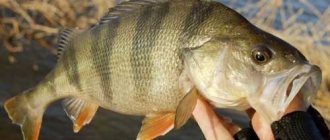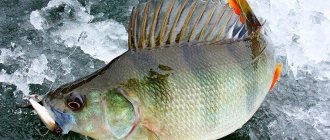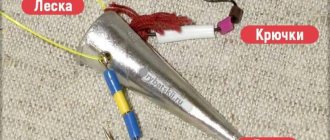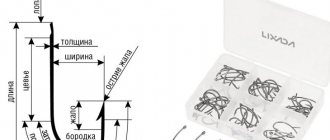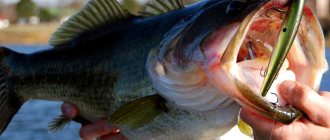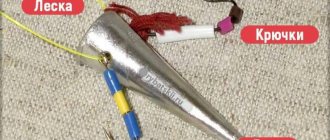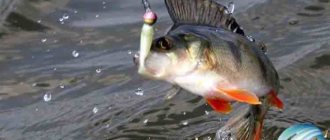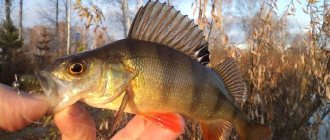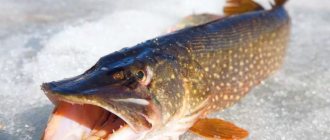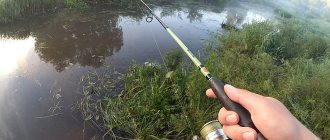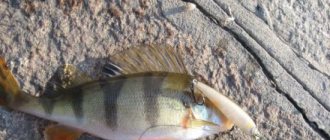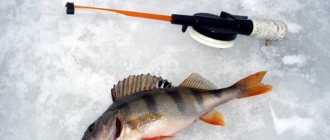Perch is one of the most common predators living in freshwater bodies of our country. Fishing for it is very interesting and exciting, but many professionals do not like to hunt for it, preferring more serious opponents. As for beginners, perch fishing can help them gain experience and gain invaluable experience, so that in the future hunting for other predators will not seem so difficult.
As is the case with catching any fish, for the hunt to be effective, you need to be well prepared before going out onto the pond. The main stages of preparation include choosing bait for perch. The predator has its own tastes and preferences, and where one bait does not work, another attracts it like an iron magnet.
Types of bait
Perch is famous for its unpretentiousness to the baits used. Thanks to this, catching it is relatively easy, since finding catchable bait is much easier than for fishing for other predators. Sometimes the fisherman does not have to sort through at all, since the first bait used attracts the predator well and gives results immediately.
The following devices are most often used for catching perch:
microoscillators;- turntables;
- various silicone baits;
- wobblers;
- tail spinners;
- cicadas;
- micro spinnerbaits;
- top waters;
- jigs.
From the above list, many professionals consider silicones and poppers to be the most effective.
Silicone baits are universal. With their help, predators can be caught at different times of the year and in different bodies of water, and in winter fishing, silicones have no equal among all baits.
A huge range of silicone baits allows the fisherman to choose a product of any shape, size and color. Among all the existing options, everyone will find the best one for themselves.
Products made from edible rubber are extremely popular. They are made of silicone with the use of fragrances. After immersion in water, the product actively releases attractants that attract predators. In addition, the rubber is soft, making the fish more willing to bite without feeling the catch. As a result, the number of fish caught can be very large.
Poppers are included in the top water class. A distinctive feature of this species is that they work close to the surface of the water or directly on the surface. The popper is a noisy bait and attracts predators with the sound it makes during the retrieve.
Application of edible rubber
There are a large number of types of edible rubber sold in fishing stores. The most popular among them are the following categories:
Twister is a smooth or ribbed bait in the shape of a small fish that has one or two tail fins. It is most often used for jig fishing for perch, in which the bait is additionally equipped with a sinker, and also in an unloaded state.- Vibrotail is an elongated fish with a tail, usually located perpendicular to the main part of the bait. Suitable for both jig fishing and fishing in the upper layers of the reservoir. When performing the first type of fishing, step fishing is the most popular and effective.
- The slug belongs to the subcategory of passive baits that do not play in the water, but are quite attractive to predators if handled skillfully. For beginners, fishing with this bait will be difficult as it requires skillful animation with a professional hand. The slug is equipped with an offset hook.
- The silicone worm resembles a regular worm in appearance. They hook you like a live fish. A prerequisite is that there must be a diverting leash.
- Silicone crayfish is used by fishermen to catch fish that spend a lot of time near the bottom of the reservoir. Jerky wiring is performed with long pauses.
- The silicone pipe has no analogues in appearance among representatives of the fauna, but this does not prevent it from attracting many predators. With this attachment you can also catch peaceful species of fish.
According to experienced fishermen, the most catchy ones are Daiwa Tournament, Sexy Impact (Keitech), Reins, Crazy Fish.
The undeniable advantage that edible perch rubber has is its low cost. I am also pleased with the effectiveness of fishing with their use. On the other side of the scale is a small expiration date. For example, if the bait attracts a pike, then after the first blow, it may be left without a tail.
With edible rubber you can go fishing at any time of the year. She will not leave the fisherman without a catch. But one thing to consider is that this type of bait is more effective in cold water, so the best time for fishing is considered to be late autumn and winter.
Rotating lures for perch
“Spinners” can perhaps be called the most popular type of perch bait. From my own experience, I can say that fishing results improve significantly if you use baits that can be carried out at maximum depths. For these conditions, the choice of turntables is very large, but all of them, as a rule, have a large petal, but choosing a sufficiently heavy turntable with a small petal is not so easy.
Of course, light spinners can also be used, for example, in shallow water, when fighting perch near the surface, as well as in places with a grassy bottom, where placing heavier baits is difficult.
The weighty body gives the spinner good characteristics for throwing, as well as for maintaining a certain depth of motion. But, although a large and heavy petal, adding weight, increases the depth of the stroke, it also slows down the intensity of the game, and such a bait strongly twists the line, which is practically not the case with spinners with a small petal. And vice versa, if the spinner has a large petal and a light body, then you will not cast the bait over a long distance, and when throwing it will be blown away by the wind.
The negative aspect of this type of bait is that the spinners twist the fishing line. The intensity of twisting can be reduced by using high-quality swivels. In addition, slowing down the retrieve significantly reduces line twist. If a keel weight is placed in front of the bait, the twist disappears completely.
In deep places, the weight of spinners, which are good for catching large perches, is, as a rule, 10-22 grams. The best ones are those that have a front weight head. It is believed that such models are more suitable for catching pike, however, they sometimes turn out to be very effective for perch. The petal rotates not only when retrieving, but also when the bait is immersed (free fall). Those who catch “deep” perches usually use 18-gram models, however, sometimes they use more than 25 grams.
I will list several deep-plunging “spinners” (see Table 1) that can be safely recommended for catching perch. Here and further, in addition to those models with which I myself go fishing for perch, there are those baits that I managed to “spy” from other spinning anglers who systematically achieve high results when catching this fish: Mepps Lusox - the weight of standard heads is from 4 to 13 grams. Spin-naren - with weights of 18 and 28 grams. Minnow Chaser (3 cm - 12 grams and 5 cm - 14 grams). Balance-Lippa (Kuasamo) and although the weight of this bait is 14 grams, the light petal ensures stable play with slow retrieval. And of course, Mor-rum Spinner (Abu Garcia), which over the past fifteen years has been the most catchy for me. The enumeration can take a very large volume, the main thing is not to be afraid to experiment, because any combination is possible - spinner - removable weight - head.
To catch perch near the surface and in the grass in inland waters, spinners of size 0-3 are usually used (see Table 2). Most often, their weight is 1-8 grams. As for the smallest UL spinners, their weight usually does not allow for long throws. To do this, they must have additional weights (see article by M. Balachevtsev in the previous issue).
If the bite is bad, the effectiveness of the bait can be increased by attaching a piece of orange silicone tube, a red woolen thread, a colored tee or hook to the tee, or by winding a feather.
If the bite is good, larger baits are preferred; this can help ensure that larger specimens are caught. If the bite is sluggish, then it is better to use smaller baits, including in large open reservoirs.
Application of poppers
The nose of the popper has a notch, which is its distinctive feature. During jerking, the bait makes characteristic squelching noises and this attracts predators.
The advantage of poppers is that when fishing with them, the fisherman can circle around vegetation barriers, since fishing is carried out in the upper layers of the water column. Due to this, the number of snags, and, consequently, gear breaks, is reduced to a minimum.
Also, the fisherman can watch how the bait plays and how the fish attacks it, which undoubtedly adds spectacle to the fishing.
Fishing where poppers are used for perch does not forgive the fisherman for saving money when purchasing baits. Many professional fishermen note that it is better to spend a lot of money once and buy a couple of poppers from the best Japanese manufacturers than ten budget ones. Over time, after using cheap options, the understanding of this comes on its own, but it is better to skip this step and immediately fish with high-quality bait.
A popper can give excellent results in cases where other baits have failed. For example, on hot summer days in shallow waters, fishermen were often able to catch passive and lazy perch without much difficulty. The main thing is that the popper's game is attractive to the predator, so the fisherman needs to skillfully operate the tackle.
Basic wiring is not considered difficult, and with a little practice, any inexperienced angler can handle it. After casting, a jerk is made, then there is a short pause, after which a pull-up is performed. Then everything is repeated in the same order. Sometimes the perch does not react to such wiring, since different baits play differently. Here it will be more difficult for a beginner, since in order to interest the fish, he will have to experiment.
The color of the popper is selected depending on the characteristics of the reservoir where the hunt will take place. The characteristics of the fish species living in it should be taken into account.
You shouldn’t go fishing with just one bait, even if it suits all the parameters. You should have several poppers in your arsenal so that, if necessary, you have something to replace an ineffective nozzle.
Silicone baits
With the advent of silicone baits, the idea of spinning fishing has changed dramatically. Many spinning players quickly forgot about the presence of spinners and spinners, and their arsenal was replenished with a wide variety of silicones. These are universal baits that work well throughout the season.
The most universal silicones are vibrotails and twisters. Recently, silicone baits have appeared that imitate various insects and animals, such as mice, frogs, various worms, insect larvae and the insects themselves. In this case, the perch can bite on any bait, both active and passive, such as a worm, frog, crayfish, etc. To interest the perch, you should make various movements with the rod to animate the bait. This circumstance applies to both active and passive baits.
The size of the silicone bait is selected depending on the size of the fish or its type. To catch perch, you can use silicone fishing rods with sizes ranging from 2.5 inches and above. For very small specimens, you can take baits up to 2 inches in size.
Jig fishing
This type of fishing is more popular when fishing for pike perch. She is very passionate, interesting and effective.
It is important to choose the right bait size that is suitable for the perch living in a particular body of water. It is recommended to use twisters no more than 5 cm in length. The weights used should be light in weight.
Particular attention should be paid to the quality of the twister, since bad products are quite often found in fishing stores. They need to be checked for softness, elasticity, and most importantly, for play. It should be attractive to perch.
In jig fishing, despite the high quality of the twister, the most important role is played by its correct presentation. How professionally the fisherman performs this or that type of wiring depends on how the striped fish will react to it.
You can use different wiring, but, of course, a “step” is preferable. As for the equipment, installation on a jig head, a Cheburashka sinker or on a lead is allowed.
Catching perch with a jig works flawlessly and the fisherman is never left without a catch.
Catching perch in summer with a float rod
Fishing tackle
Since the perch does not offer much resistance, the thickest fishing line can be used, 0.2-0.4 mm is enough if fishing is carried out with float tackle.
The hook must be sharp and with a long shank; as for the size, number 5 is enough .
The length of the fishing rod is selected based on the fishing conditions, but since perch most often accumulates near coastal vegetation, it is enough to have a fishing rod with a length of 2.5 to 3 meters .
a float made of a goose feather, which is secured to the fishing line using a piece of nipple in the lower and upper parts.
The weight is fixed at a distance of 20 cm from the hook ; its weight should be enough so that after throwing the tackle into the water, the float instantly takes on a vertical position and at the same time sinks by a third of its length.
The perch bite is sharp and strong, it is almost impossible to miss it, since the float suddenly goes under the water. It is at the moment when the float completely disappears under the water that it is necessary to perform a short and sharp hook. If after throwing the bait into the water there are no bites within 5 minutes, you should carefully lift the rod and tap it with your palm.
Lures for Summer Perch
In cloudy weather, the perch will ideally peck at worms, which it greedily swallows as soon as they fall into the water. The bite is always sharp and strong.
To catch perch, you can use small fish (live bait). It is best to catch live bait in the reservoir in which you plan to catch the predator. As live bait, you can use minnows, verkhovka or roach, the body length of which does not exceed 7 cm . It is important to note that when fishing with live bait, not only perch, but also pike can grab the bait, so it is recommended to equip the tackle with a small tungsten or metal leash.
In addition to the listed baits, perch is excellently caught in summer using maggots and crayfish . red leech is perfect as bait. It is worth noting that, in addition to perch, a medium-sized carp may also be tempted.
Small perch can be successfully caught using bloodworms, which are placed on the hook by the head in the amount of 3-5 pieces. Perch also reacts to grasshoppers, chafer larvae and dragonflies, but much worse than to a worm or live bait, and if these baits are available, it is better to put the top ones aside.
Before you start summer perch fishing, you should identify promising areas and find out at what depth the predator is currently located, we wrote about this a little higher. It is recommended to fish a promising place from close to far . First, we cast the bait closer to the shore and gradually move on to making long casts. It is important to note that especially large perch hunt only near the bottom, so you should try to present the bait as close to the bottom as possible. When catching perch with a worm, live bait or other natural bait, you can bait the fishing spot.
Lure
Some fishermen are sure that bait for perch is completely useless, but in most cases fishing with it is much better than without it.
Perch is a rather voracious fish that is always in search of food. Unlike non-predatory species, the striped fish needs to prepare bait from components of animal origin, although there are times when it comes to the feeding areas of bream, carp, etc.
Bloodworms are most often used as the main component. You can also add chopped worms and pieces of fish to the mixture.
To attract a predator to the fishing spot, you can prepare a treat for peaceful fish species. When the fry swim to the fished area, the predator will soon also appear to have a good hunt. For this purpose, components of plant origin are used, such as cake, breadcrumbs, etc.
Top lures for perch in early spring
narybalke
Jig baits for perch
Jig is the main bait used to catch perch by casting in deep water bodies. These baits also catch fish well in the shallows, but their use here has not yet become widespread.
The choice of cargo depends on the depth at the fishing spot. A head weighing 25-30 grams will be quite sufficient when fishing in the deepest places. The best among heavy loads are “Cheburashkas” (eared weights), which have a hinged fastening with a hook, and “bullet heads” - with these equipment options, the perch does not feel the load in the mouth as well as when using a classic jig head.
At greater depths, lighter baits can be used and used effectively. To determine the optimal weight, there is no need at all to sort the load one gram at a time in the direction of decreasing or increasing; an interval of 4-5 grams is quite enough. One of the options for the rational selection of weights for jig fishing is when each next weight is approximately 30° heavier than the previous one.
The most popular among fishermen are jig baits weighing from 5 to 18 grams. Precise weighing is not required, since you can determine the appropriate dimensions by eye, but it never hurt anyone to have markings on the loads!
Heavy head season usually occurs in the fall. In summer, lower amounts of lead are often sufficient. In calm weather or weak currents, you can control the situation at the bottom by using a lighter weight.
When fishing in small bodies of water, the maximum weight of a jig bait for perch is usually no more than 10 grams, most often within 4-8 g.
In my experience, perch catches increase if the fisherman uses heads of the lightest possible weight, depending on the depth. Although I know fishermen who use only heavy and super-heavy loads (up to 200 grams) and achieve phenomenal results, they still do not rely on the perch that we are talking about now. The weight of the bait is considered insufficient for step-by-step classic retrieve if you cannot clearly control the lowering of the load to the bottom at the end of each pause by the tip of the spinning rod or by the weakening of the fishing line. In the absence of a bite, sometimes it makes sense to further reduce the weight of the load, sacrificing the “sense of the bottom.”
When searching for perch, you don't need too large baits. When a school is discovered, you can try to catch the largest individuals, cutting off small things with larger rippers or twisters. This technique only works if the bite is good. If you are fishing in the fall on a large body of water where large perches are caught, and during a period of intense biting you find a huge school, indulge in the experiment and try to launch eighteen-centimeter twisters with sickle-shaped tails or the same silicone worms. The result may exceed your expectations! When fishing with such large baits, use only a “hinged” rig with a “eared” weight or a sliding “bullet” head. Unlike a jig head, these mounting options are less likely to prevent the swallowing of large silicone bait. Another option for “selecting” large perches can be the use of a twelve-centimeter ripper.
In general, when catching 200-500 gram perches, it is recommended to mainly use a three-inch (about 9 cm) silicone fish, and when the bite weakens, use even smaller rubber.
Two-inch (about 6 cm) tires have proven themselves well on inland waters. However, you should not be too carried away solely by the size of silicone baits, since the suitable one is selected only by those heads on which the hook has the necessary dimensions in comparison with rubber.
The hook should protrude from the back in the middle of the fish or slightly behind, but no more than 2/3 of its length from the head. If the hook is pushed too far forward, then frequent empty bites and escapes are possible, and if it is moved too far back, the playing qualities of the tail section will suffer.
It is better to use a hook for perch made of thin wire, which improves its penetrating qualities and makes sharpening easier. If you have a multi-filament fishing line, then a hook stuck on a stone simply straightens when pulled, without damaging the rubber, and the hook can be straightened and sharpened again.
When purchasing silicone baits, it is recommended to pay attention to the quality of the tail part. The wide tail gives good play. As for the optimal color, this issue is resolved experimentally, taking into account specific fishing conditions. I personally like green, dark red, tan and black colors. In murky waters, perch can be caught well with yellow, white and orange baits.
